HIV-1 Capsid Rapidly Induces Long-Lived CPSF6 Puncta in Non-Dividing Cells, but Similar Puncta Already Exist in Uninfected T-Cells
- PMID: 38793552
- PMCID: PMC11125723
- DOI: 10.3390/v16050670
HIV-1 Capsid Rapidly Induces Long-Lived CPSF6 Puncta in Non-Dividing Cells, but Similar Puncta Already Exist in Uninfected T-Cells
Abstract
The HIV-1 capsid (CA) protein forms the outer shell of the viral core that is released into the cytoplasm upon infection. CA binds various cellular proteins, including CPSF6, that direct HIV-1 integration into speckle-associated domains in host chromatin. Upon HIV-1 infection, CPSF6 forms puncta in the nucleus. Here, we characterised these CPSF6 puncta further in HeLa cells, T-cells and macrophages and confirmed that integration and reverse transcription are not required for puncta formation. Indeed, we found that puncta formed very rapidly after infection, correlating with the time that CA entered the nucleus. In aphidicolin-treated HeLa cells and macrophages, puncta were detected for the length of the experiment, suggesting that puncta are only lost upon cell division. CA still co-localised with CPSF6 puncta at the latest time points, considerably after the peak of reverse transcription and integration. Intriguingly, the number of puncta induced in macrophages did not correlate with the MOI or the total number of nuclear speckles present in each cell, suggesting that CA/CPSF6 is only directed to a few nuclear speckles. Furthermore, we found that CPSF6 already co-localised with nuclear speckles in uninfected T-cells, suggesting that HIV-1 promotes a natural behaviour of CPSF6.
Keywords: CPSF5; CPSF6; HIV-1; T-cell; capsid; macrophage; nuclear speckle; uncoating.
Conflict of interest statement
The authors declare no conflicts of interest. The sponsors had no role in the design, execution, interpretation, or writing of the study.
Figures

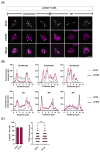
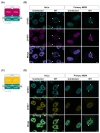
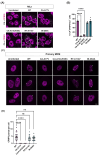
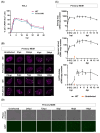
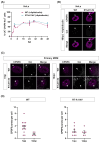
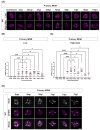
Similar articles
-
HIV-1 usurps mixed-charge domain-dependent CPSF6 phase separation for higher-order capsid binding, nuclear entry and viral DNA integration.Nucleic Acids Res. 2024 Oct 14;52(18):11060-11082. doi: 10.1093/nar/gkae769. Nucleic Acids Res. 2024. PMID: 39258548 Free PMC article.
-
Formation of nuclear CPSF6/CPSF5 biomolecular condensates upon HIV-1 entry into the nucleus is important for productive infection.Sci Rep. 2023 Jul 6;13(1):10974. doi: 10.1038/s41598-023-37364-x. Sci Rep. 2023. PMID: 37414787 Free PMC article.
-
Truncated CPSF6 Forms Higher-Order Complexes That Bind and Disrupt HIV-1 Capsid.J Virol. 2018 Jun 13;92(13):e00368-18. doi: 10.1128/JVI.00368-18. Print 2018 Jul 1. J Virol. 2018. PMID: 29643241 Free PMC article.
-
HIV Capsid and Integration Targeting.Viruses. 2021 Jan 18;13(1):125. doi: 10.3390/v13010125. Viruses. 2021. PMID: 33477441 Free PMC article. Review.
-
HIV-1-induced translocation of CPSF6 to biomolecular condensates.Trends Microbiol. 2024 Aug;32(8):781-790. doi: 10.1016/j.tim.2024.01.001. Epub 2024 Jan 23. Trends Microbiol. 2024. PMID: 38267295 Free PMC article. Review.
Cited by
-
The role of chromatin in retroviral preintegration complex function.J Biol Chem. 2025 Jul 3;301(8):110440. doi: 10.1016/j.jbc.2025.110440. Online ahead of print. J Biol Chem. 2025. PMID: 40615040 Free PMC article. Review.
-
Retrointegration2023-Papers from the 7th International Conference on Retroviral Integration.Viruses. 2025 Jun 23;17(7):879. doi: 10.3390/v17070879. Viruses. 2025. PMID: 40733497 Free PMC article.
-
Disruption of CPSF6 enhances cellular permissivity to HIV-1 infection through alternative polyadenylation.Res Sq [Preprint]. 2024 Dec 4:rs.3.rs-5099896. doi: 10.21203/rs.3.rs-5099896/v1. Res Sq. 2024. PMID: 39678349 Free PMC article. Preprint.
-
HIV-1 Infection Regulates Gene Expression by Altering Alternative Polyadenylation Through CPSF6 and CPSF5 Delocalization.bioRxiv [Preprint]. 2025 Aug 7:2025.08.07.669137. doi: 10.1101/2025.08.07.669137. bioRxiv. 2025. PMID: 40827274 Free PMC article. Preprint.
-
HIV-1 usurps mixed-charge domain-dependent CPSF6 phase separation for higher-order capsid binding, nuclear entry and viral DNA integration.Nucleic Acids Res. 2024 Oct 14;52(18):11060-11082. doi: 10.1093/nar/gkae769. Nucleic Acids Res. 2024. PMID: 39258548 Free PMC article.
References
MeSH terms
Substances
Grants and funding
LinkOut - more resources
Full Text Sources
Molecular Biology Databases

